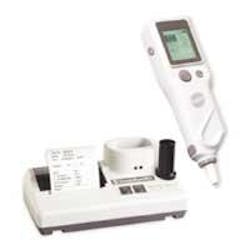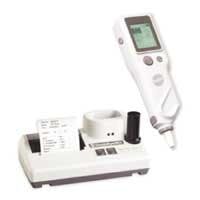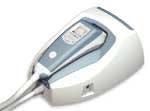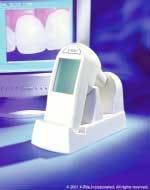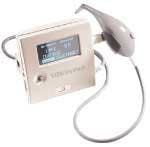A look at shade-matching technology
By Paul Feuerstein, DMD
When asked what the most difficult dental procedure is, many dentists respond, "crown on one central." It is so demanding that many practitioners tell the patients that it is impossible, then crown both centrals or even more teeth. It is true that there are a multitude of new metal-free restorations, all promising the world of beauty. One of the factors is shade- and color-matching.
I have discussed in previous articles in Dental Economics the use of photography for shade-matching, using variable lighting. In one such technique, developed by Dr. Ed Walk of Tufts University, several photos are taken of the same area with a shade guide, each at a different light setting. This is easily done with the Polaroid Macro 5, but can certainly be done with several digital cameras. The lab can extrapolate the shade, density, and translucency from these photos.
In this critical situation though, there may be a better way. There are now several shade-matching devices on the market, all using different technologies. Several companies have entered this market each taking a different method of approaching this problem. Two technologies (spectrophotometry and colorimetry) are used in these systems (feel free to research these terms, but each manufacturer will explain why theirs is the better one). All systems, with one exception, use a handheld device that is placed either on or in front of the tooth in question. Shields are used for both sterility and blocking out ambient light. In some systems, an image of the tooth will show up on a screen on the handheld device, much like what you would see in a digital camera. These units are taking a map of the entire tooth. The other units take a spot or spots on the tooth and do an analysis that gives specific numeric information representing specific porcelain shades. One system, Clear Match, does not use a special device at all. This is actually software that interprets images taken with a standard digital camera.
With accompanying software, the dentist (or lab) can not only extrapolate shades, but hue, chroma, and value, a confusing set of parameters to many practitioners. For example, the Vident unit uses values corresponding to its Vitapan 3D-Master, which is set up using these values as well as classic Vita shades. The other units also give these parameters and give directions depending on which shade guide or porcelain you plan on using — some graphically, some numerically, and some both.
Once a shade is taken, the information can be sent to a lab by print-out, disk, or e-mail. If the raw data is sent, the lab will be required to have the equivalent software. In the best situation, the lab has the same unit as the practitioner. In this case, the lab can take an electronic shade of the crown before it is sent back to the dental office making. This, in essence, is what X-Rite, manufacturer of the ShadeVision system, calls the "virtual try-in." In states where the lab can take shades, it will be an excellent addition for the technician's arsenal. Taking it a step further, labs that have demanding accounts can purchase these units and lend them to their accounts for use in critical cases. If practitioners see the value of this, they will find it more convenient to have their own. Of course, the reverse situation would be the dentist lending the unit to the lab.
One other area where these units could be helpful is with respect to tooth-whitening. The office can give a more accurate assessment of the bleaching results with the various systems.
For now, most offices will still rely on staff members whose clothes and eyeshadow are in perfect coordination. Of course, the ultimate experts are the patients. They commonly use a technology called the "rear view mirror." We have all seen the patient get into the car and do a final check before they drive away from the office. Perhaps a call to X-Rite is in order. After all, X-Rite is also in the auto paint matching business and may have a few mirrors it can sell us.
ShadeEye NCC by Shofu
The New ShadeEye NCC Dental Chroma Meter will give the operator a recipe to reproduce an exact porcelain restoration in the Shofu Vintage Halo porcelain system and a reading for other shade guide systems such as (Vita 3D Master, Chromascop, Vita Classical, NCC, and Biodent). This information can be printed out on the base unit or transferred to a your personal computer using the Shade Eye Viewer software. The software allows you to record all the patient's shade information and attach digital photographs and then e-mail to the laboratory. For more information, call (800) 82-SHOFU or log on to www.shofu.com.
ShadeScan¿ by Cynovad
ShadeScan™ measures shades over the entire tooth surface, then analyzes and communicates dental shades by generating a complete report according to any shade guide system. A visual of the tooth image captured with the ShadeScan™ along with a characterization image and a translucency map, can also be included in a printed report. ShadeScan™ as a diagnostic tool to produce and communicate a precise shade prescription, particularly for fixed prostheses, direct restorations, and tooth-whitening treatment monitoring. For more information, visit www.cynovad.com or call (866) CYNOVAD.
ShadeVision System by X-Rite
The cordless, handheld ShadeVision System uses advanced colorimeter technology to consistently determine the hue, value and chroma of the teeth. Within seconds, images are conveniently captured and the data is uploaded to the dentist's personal computer for processing. This information is easily communicated to the laboratory electronically, or printed out. The lab now has objective data to fabricate and verify the restoration's esthetics. As a result, productivity is improved, remakes reduced, and patient office time minimized. For more information, visit www.shadevision.com or call (866) 61-SHADE.
VITA Easyshade¿ by Vident
Vident envisions the device as an ideal quality-control unit for dental laboratories. It features a handpiece that contains multiple spectrophotometers connected to a touch-screen readout. The tip of the probe is covered with a transparent infection-control sleeve and gently placed against the tooth. The readout provides prescriptions in both Vitapan 3D-Master and VITA Classical shades. Within seconds of touching the tooth, the instrument highlights the closest shade match. For more information, log on to www.vident.com or call (800) 828-3839.
